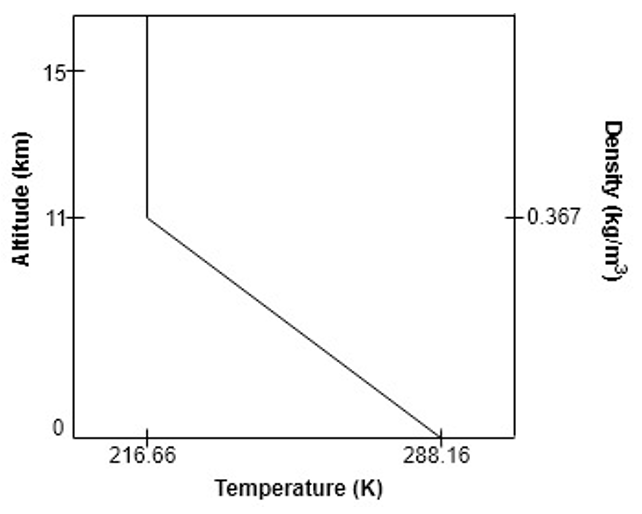This set of Spaceflight Mechanics Multiple Choice Questions & Answers (MCQs) focuses on “Standard Atmosphere – Set 2”.
1. Cabin pressurization is ideal for vehicles travelling through the stratosphere.
a) True
b) False
View Answer
Explanation: False because the stratosphere contains the ozone and cabin pressurization in the stratosphere could lead to ozone poisoning. Also, because the density at that altitude is very low.
2. Which of the following engines will propel a vehicle travelling through the mesosphere?
a) Turbofan engine
b) Internal Combustion Engine
c) Turbojet Engine
d) Rocket Engine
View Answer
Explanation: All engines except the rocket engine require air to function. Since, there is no air/atmosphere within the mesosphere only a rocket engine will work. Rocket engine has its own propellant and oxidizer.
3. What is the coldest isothermal layer of our atmosphere?
a) Tropopause
b) Stratopause
c) Mesopause
d) Exopause
View Answer
Explanation: Mesopause is the coldest isothermal layer. It has a temperature of about 190 K or -83°C. Tropopause and Stratopause are relatively warmer. Whereas, exopause doesn’t exist.
4. Only a high-altitude balloon can park in the mesosphere layer.
a) True
b) False
View Answer
Explanation: True since mesosphere is too low for spacecrafts and too high for aircrafts to park into or to travel across. This layer is also referred to as “no-person’s land”.
5. U.S. Air Force defines the ____________ as the boundary between earth’s atmosphere and space.
a) Kármán line
b) Van Allen belt
c) Beginning of exosphere
d) Beginning of mesosphere
View Answer
Explanation: The beginning of space is officially denoted at an altitude of 100 km which is also known as the Kármán line. After this line the aerodynamic effects are minimal. Cold gas thrusters are used to correct orientation after this line as aerodynamic control surfaces are useless.
6. Saturn is a giant gas planet made up of Hydrogen. The specific gas constant for Hydrogen is 4157 J/kg.K. The acceleration due to gravity on Saturn is 10.44 m/s2. Assuming an isothermal atmosphere with a temperature of 90 K, what is the altitude above Saturn’s surface where the pressure is one-third of the surface pressure.
a) 30.52 km
b) 39.37 km
c) 25.12 km
d) 33.12 km
View Answer
Explanation: Given,
Hydrogen gas constant (R) = 4157 J/kg.K
Isothermal temperature (T) = 90 K
Acceleration due to gravity (g) = 10.44 m/s2
Pressure ratio (p/p1) = 1/3
Surface height (h1) = 0 km
We know, for isothermal regions
ln (p/p1) = -(g/RT)(h-h1)
Pressure altitude, h = h1 – (RT/g).ln(p/p1)
= 0 – (4157*90/10.44)*ln(1/3)
= 39.37 km
7. Using Toussaint’s formula, what is the temperature of air at a geopotential altitude of 4 km?
a) 262 K
b) 231 K
c) 250 K
d) 255 K
View Answer
Explanation: Toussaint’s formula is given by T = 15 – 0.0065h
Where, T is the temperature in Celsius and h is the geopotential altitude in metres.
Therefore, T = 15 – 0.0065*(4000)
= – 11°C
= -11 + 273 K
= 262 K
8. What is the temperature of air if the pressure and density are 629.66 lb/ft2 and 0.9408 x 10-3 slug/ft3. Given specific gas constant is 1716 lb.ft/slug.0R.
a) 125 0R
b) 250 0R
c) 225 0R
d) 390 0R
View Answer
Explanation: Given,
Pressure (p) = 629.66 lb/ft2
Density (ρ) = 0.9408 x 10-3 slug/ft3
Specific gas constant (R) = 1716 lb.ft/slug.0R
Using equation of state,
Temperature, T = p/(ρR)
= 629.66/(0.9408*10-3*1716)
= 390 0R
9. What is the density of air at a geopotential altitude of 15 km? Given, acceleration due to gravity and specific gas constant are 9.81 m/s2 and 287 J/kg.K respectively. All the information is provided in the diagram below.

a) 0.125 kg/m3
b) 0.178 kg/m3
c) 0.257 kg/m3
d) 0.195 kg/m3
View Answer
Explanation: Given,
Acceleration due to gravity (g0) = 9.81 m/s2
Specific gas constant (R) = 287 J/kg.K
At point 1 (11 km), Density, ρ1 = 0.367 kg/m3
At point 2 (15 km), Density, ρ2 = ?
At both points, temperature remains the same, T = 216.66 K
For isothermal layers,
ln(ρ2/ρ1) = -(g0/(RT))(h2 – h1)
ln(ρ2/0.367) = -(9.81/(287*216))*(15,000-11,000)
ρ2 = 0.367e-0.631
= 0.195 kg/m3
10. What is the rate of change of pressure with altitude at a geopotential altitude of 10 km? Given, temperature at 10 km is 222.6 K, specific gas constant is 287 J/kg.K and acceleration due to gravity is 9.81 m/s2.
a) 1.96 x 10-3 per meter
b) 1.03 x 10-4 per meter
c) 1.54 x 10-4 per meter
d) 1.12 x 10-3 per meter
View Answer
Explanation: Given,
Acceleration due to gravity (g) = 9.81 m/s2
Specific gas constant (R) = 287 J/kg.K
Temperature (T) = 222.6 K
Combining hydrostatic equation and equation of state we get,
Change in pressure with altitude, (dp/p)/dh = g/(RT)
= 9.81/(287*222.6)
= 1.54 x 10-4 per meter
Sanfoundry Global Education & Learning Series – Spaceflight Mechanics.
To practice all areas of Spaceflight Mechanics, here is complete set of 1000+ Multiple Choice Questions and Answers.
If you find a mistake in question / option / answer, kindly take a screenshot and email to [email protected]
